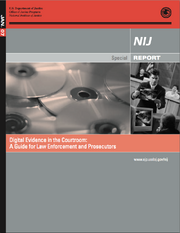No edit summary |
No edit summary |
||
| (2 intermediate revisions by the same user not shown) | |||
| Line 1: | Line 1: | ||
== Citation == |
== Citation == |
||
| − | [[U.S. Department of Justice]], Office of Justice Programs, [[National Institute of Justice]], '''Digital Evidence in the Courtroom: A Guide for Law Enforcement and Prosecutors''' (Jan. 2007) ([http://www.ncjrs.gov/pdffiles1/nij/211314.pdf full-text]). |
+ | [[U.S. Department of Justice]], [[Office of Justice Programs]], [[National Institute of Justice]], '''Digital Evidence in the Courtroom: A Guide for Law Enforcement and Prosecutors''' (Jan. 2007) ([http://www.ncjrs.gov/pdffiles1/nij/211314.pdf full-text]). |
== Overview == |
== Overview == |
||
| + | |||
| + | [[File:DigEvid.png|thumb]] |
||
[[Computer]]s have also become increasingly important to criminals, who steal [[information]], commit [[fraud]], and [[Cyberstalking|stalk]] victims [[online]]. Even if a crime was not committed [[online]], law enforcement may discover critical [[evidence]] from an offenders' [[digital media]]. For this [[evidence]] to be admissible, however, police must demonstrate proper collection and handling. In the courtroom, prosecutors must overcome the twin barriers of skepticism and lack of technical understanding. |
[[Computer]]s have also become increasingly important to criminals, who steal [[information]], commit [[fraud]], and [[Cyberstalking|stalk]] victims [[online]]. Even if a crime was not committed [[online]], law enforcement may discover critical [[evidence]] from an offenders' [[digital media]]. For this [[evidence]] to be admissible, however, police must demonstrate proper collection and handling. In the courtroom, prosecutors must overcome the twin barriers of skepticism and lack of technical understanding. |
||
To help navigate this complex process, NIJ's technical working group of national experts prepared this special report. Chapters 1 and 2 inform crime scene investigators and other handlers about legal requirements for the handling of [[digital evidence]]. Chapters 3 and 4 provide guidelines for successful prosecution. The last chapter is a working application — using [[digital evidence]] to convict in a [[child pornography]] case. Appendixes provide useful resources and forms. |
To help navigate this complex process, NIJ's technical working group of national experts prepared this special report. Chapters 1 and 2 inform crime scene investigators and other handlers about legal requirements for the handling of [[digital evidence]]. Chapters 3 and 4 provide guidelines for successful prosecution. The last chapter is a working application — using [[digital evidence]] to convict in a [[child pornography]] case. Appendixes provide useful resources and forms. |
||
| + | |||
| + | == See also == |
||
| + | |||
| + | * [[Forensic Examination of Digital Evidence: A Guide for Law Enforcement]] |
||
[[Category:Publication]] |
[[Category:Publication]] |
||
[[Category:Criminal]] |
[[Category:Criminal]] |
||
Latest revision as of 16:53, 11 November 2012
Citation[]
U.S. Department of Justice, Office of Justice Programs, National Institute of Justice, Digital Evidence in the Courtroom: A Guide for Law Enforcement and Prosecutors (Jan. 2007) (full-text).
Overview[]

Computers have also become increasingly important to criminals, who steal information, commit fraud, and stalk victims online. Even if a crime was not committed online, law enforcement may discover critical evidence from an offenders' digital media. For this evidence to be admissible, however, police must demonstrate proper collection and handling. In the courtroom, prosecutors must overcome the twin barriers of skepticism and lack of technical understanding.
To help navigate this complex process, NIJ's technical working group of national experts prepared this special report. Chapters 1 and 2 inform crime scene investigators and other handlers about legal requirements for the handling of digital evidence. Chapters 3 and 4 provide guidelines for successful prosecution. The last chapter is a working application — using digital evidence to convict in a child pornography case. Appendixes provide useful resources and forms.